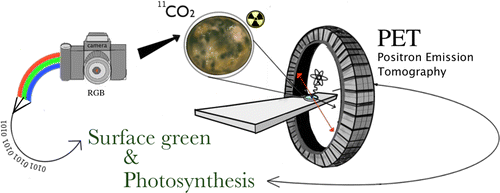Biological soil crusts (BSCs) are critical contributors to the biogeochemistry of ecosystems in arid and semi-arid regions worldwide. Photosynthetic microorganisms such as cyanobacteria are often the predominant primary producers, fixing both carbon and nitrogen and producing polysaccharides that aid in soil stabilization. Here, we exposed BSCs to 11CO2 and quantified the spatial distribution of carbon fixation in BSCs on a millimeter scale using positron emission tomography (PET). These experiments showed that live BSCs fixed up to 20 times more carbon than abiotic controls. The results present values for correlations between biological carbon fixation and a proxy for chlorophyll concentration derived from photographs. For the first time, we apply PET imaging, a tool that holds great potential for noninvasively characterizing and mapping biological function either on the surface or deep within opaque environmental matrices, to gain a better understanding of system function and organization with application to photosynthetic microbes in biological soil crusts.
Nicholas T. Vandehey *†, Trent R. Northen †, Eoin L. Brodie ‡§, and James P. O’Neil †
†Life Sciences Division and ‡Earth Sciences Division, Lawrence Berkeley National Laboratory, Berkeley, California 94720, United States
§ Department of Environmental Science, Policy and Management, University of California, Berkeley, California 94720-3114, United States

